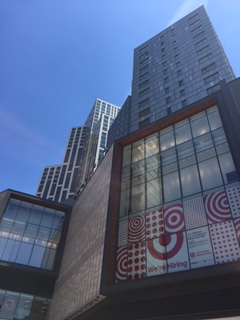
One way to get to know a neighborhood is by exploring its buildings. So we did. This story is part of a series in The Brooklyn Ink on some of the structures in the borough, and what they tell us about the life in and around them.
City Point Towers—at 138 Willoughby Street, 7 Dekalb Avenue, and 10 City Point—will introduce hallmarks of wealth such as Trader Joe’s to Downtown Brooklyn by the end of the year, another signal of the neighborhood’s shifting economy. The Towers are planning to open a branch of the high-end grocery store soon, as well as a Target by the end of the summer, according to Trader Joe’s and Walgreen’s websites.
Locals look at the three immense Towers, reaching up to 57 stories and forecast to include two of the largest buildings in the area, as proof their neighborhood has become a home to the wealthy. “There are new people, new buildings,” said Anthony John, a Downtown Brooklyn resident. “I don’t even recognize this area anymore.”
Construction for the Towers—which sold for as much as $115.5 million for Tower Three to the luxury real-estate company Extell in 2015—is expected to finish in 2020.
City Point Towers were a project originally championed under former Mayor Michael Bloomberg to create both luxury buildings that would bring more money to Downtown Brooklyn as well as provide affordable housing. In Tower One, 200 units out of 250 are dedicated to affordable housing, according to NYC.gov.
But, on the other hand, the buildings are the epitome of the new gentrified Brooklyn. The towers have rents up to $2,811 for a studio in City Point Tower Two, according to City Point’s website. Tower One costs $2,455 for a two-bedroom apartment.
Some Downtown Brooklyn residents say they are not frustrated with the City Point Towers as standalone buildings, but with the trend they seem to represent. Ryan Somerville, an employee at the JP Morgan Chase in the area, pointed to several tall residential buildings under construction, all in his line of sight. “They’ve knocked out all the old warehouses to build these skyscrapers,” said Somerville. Downtown Brooklyn, he said, was becoming a neighborhood of skyscrapers. Construction projects are numerous. “I think there are too many of them, there doesn’t seem to be a plan,” said Susan Phillip, a Downtown Brooklyn resident. “It’s all helter-skelter.”
Expensive new housing has already changed the character of the area. As wealthier people move in, many of those who previously resided in Downtown Brooklyn are pushed out. Melvin Royal is one of those. He now lives in Long Island because he cannot afford to stay in Downtown Brooklyn, where he works, anymore. He says he first noticed the shift in the retails stores. He worked in neighborhood shops until several years ago, when he started working at the H&M in Fulton Mall. “A couple years ago there’s no chance there’d be an H&M here,” he said.
The average household income in Downtown Brooklyn has increased by 64 percent since 2000, according to the regional demographic site point2homes.com, to $147,520.


Leave a Reply